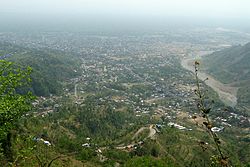Dharan, Nepal
|
Dharan धरान |
|
|---|---|
| Sub-Metropolitan City Hill station |
|

Dharan from hill sides
|
|
| Nickname(s): Queen of The East, City of लाहुरे | |
| Motto: "To build an environmentally sound city, functioning as the centre of education, health, tourism and business with fully developed infrastructure". | |
| Location of Dharan in Nepal | |
| Coordinates: 26°49′0″N 87°17′0″E / 26.81667°N 87.28333°ECoordinates: 26°49′0″N 87°17′0″E / 26.81667°N 87.28333°E | |
| Country |
|
| Zone | Koshi Zone |
| District | Sunsari District |
| Incorporated | November 16, 1960 |
| Government | |
| • Body | Dharan Sub-metropolitan city |
| • Executive Officer | Bishnu Prasad Koirala |
| Area | |
| • Total | 74.37 sq mi (192.61 km2) |
| • Water | 1.7 sq mi (4.4 km2) |
| Elevation | 1,201 ft (366 m) |
| Population (2011) | |
| • Total | 141,439 |
| • Density | 1,901.9/sq mi (734.33/km2) |
| • Ethnicities (Majorities) | Limbu, Rai, Khas (Chhetri & Brahmin), Newar |
| • Ethnicities (Minorities) | Magar, Gurung, Tamang, Yakha, Sunuwar, Dalits, Marwari, Madeshi |
| Languages | |
| • Official | Nepali |
| Time zone | NST (UTC+5:45) |
| Postal Code | 56700 (Sunsari), 56702 (Mangalbare) |
| Telephone code | 025 |
| Website |
www.dharan.gov.np dharanmun.gov.np |
Dharan (Devanāgarī: धरान) is one of the Metropolitan cities in eastern Nepal, in the Sunsari District, and is situated on the foothills of the Mahabharat Range in the north with its southern tip touching the edge of the Terai region at an altitude of 1148 ft (349m). It serves as a trading post between the hilly region and the plains of Terai region. It was once the location of a recruitment center for the Brigade of Gurkhas, opened in 1953. The recruitment center is closed and the campus is now the home of B.P. Koirala Institute of Health Sciences since 1993. Dharan Sub-metropolitan city organised a Golden Jubilee celebration of Dharan from January 28 to January 31, 2011 marking the 50th year of establishment of the municipality. It is the second-largest city of Eastern Nepal. It is also known as the soccer/footballer producing factory of Nepal.
The Ten Kings of Limbus came together to formally declare all the ten kingdoms between the Arun River and Teesta River to be called "Yakthung Laaje".
The ten rulers, their kingdoms and their forts:
After a brief period, King Mawrong Hang came to prominence and took over Terai lands of Chethar, Bodhey, Panthar and Ilam (present day Jhapa, Morang Sunsari and Dhankuta). He named his Kingdom Morang after his name and rose to power. He subdued all the Ten Limbu Kings of Limbuwan and became their overlord. He died without any male heir and King Uba Hang took over as supreme ruler of Limbuwan in 849 – 865 AD. He made many religious and social reforms in Limbuwan. Uba Hang's worthy son Mabo Hang succeeded him in 865 AD and ruled till 880 AD. Uba hang kept on with the reforms his father had started. Uba Hang was succeeded by his son Muda Hang. Muda Hang was a weak ruler so the local chiefs started ruling their areas independently. Muda Hang was succeeded by his son Wedo Hang, by this time Limbuwan was in chaos and every principality was ruling independently and fighting with each other. Wedo hang was murdered and his son Chemjonghang succeeded.
...
Wikipedia

